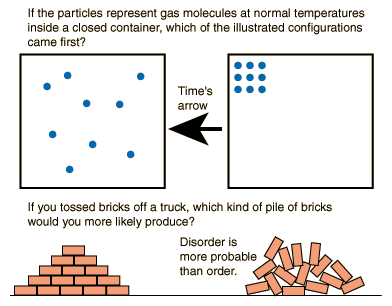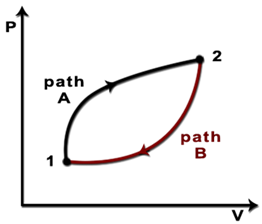Second Law of Thermodynamics and Entropy: Difference between revisions
No edit summary |
No edit summary |
||
| Line 1: | Line 1: | ||
Alyssa Candelmo (acandelmo6) | Alyssa Candelmo (acandelmo6) | ||
==The Main Idea== | ==The Main Idea== | ||
Revision as of 15:08, 2 April 2017
Alyssa Candelmo (acandelmo6)
The Main Idea
Entropy represents the quantity of the unavailability of a systems thermal energy to be converted into mechanical work. The entropy of the system can also be described as the systems level of disorder or randomness. The more entropy a system has, the more random it will be. The second law of thermodynamics states that the entropy of the universe will always increase over time. The second law also states that change in the entropy of the universe will never be negative. Essentially, through the discovery that heat can not spontaneously flow from a colder body to a hotter body, physicists also discovered that is impossible to complete any physical process without the loss of some useable energy. As time goes on, randomness can only increase.

A Mathematical Model
Boltzmann's Equation: ΔS = K lnΩ
- Where ΔS is the change in entropy of the system
- K is the Boltzmann's Constant (or 1.38065 × 10‾²³ J/K)
- Ω is the number of microstates corresponding to a given macro state
The Second Law of Thermodynamics: ΔS = ΔQ/T, and ∫ΔQ/T ≤ 0
- Where ΔS is the change in entropy of the system
- ΔQ is the change in heat of the system,
- T is the temperature at the point where the heat transfer took place
Example
Considering the cycle made by taking path A followed by path B, using the given calculated integrals, determine if the cycle is reversible, irreversible, or impossible.



We use the second law of thermodynamics and the Clausius inequality(∫ΔQ/T ≤ 0) to draw the conclusions that if the cyclic integral is:
- Positive: the cycle is impossible
- Negative: the cycle is irreversible
- Zero: the cycle is reversible
We use the equation above to include both paths in our cycle, and plug in their given values.
∫ΔQ/T = -27.7 + 41.3 = 16.6
Because the value is > 0, we conclude that the cycle is impossible.
Connectedness
How is this topic connected to something that you are interested in?
For someone who loves to cook as much as I do, entropy plays a surprisingly large role. For example, entropy is the reason that Crystal Light power resolves in water. Over time, the particles spread and spread because the more spaced out they are, the more disorderly they are. And as we know, disorder must increase with time.
How is it connected to your major?
As an Industrial and Systems Engineering Major, a lot of the work I do will be designing production plants to be as efficient as they can possibly be. Understanding the concept of entropy and that no physical process can be completed without the loss of energy will help me to be able to account for that energy loss in my plans so that I can minimize the amount of inefficiency that occurs because of it. To understand that disorder is inherently more probable than order can help me be aware of more possible outcomes.
Is there an interesting industrial application?
The second law of thermodynamics is especially used in any industry making insulted products. Well, it is not "used" so much as it is fought against. Using the specifics of the second law of thermodynamics, companies who make thermos' or lunch boxes or insulation need to understand entropy and the second law to learn how to best fight heat dissipation so that they can keep hot things hot and cold thing cold.
History
Contributors in the Development of the Second Law:

- Nicholas Léonard Sadi Carnot (1 June 1796 – 24 August 1832)
- Considered to be the father of Thermodynamics
- Major Scientific Contributions:
- Carnot heat engine
- Carnot theorem
- Carnot efficiency
- His research was centered around learning if the work available from a heat source was limited, and whether the efficiency of a heat engine could be improved upon by replacing steam with a different substance

- Rudolf Clausius ( 2 January 1822 – 24 August 1888)
- German Physicist
- Developed the Clausius statement, which states that in general, heat can not flow spontaneously from a low temperature to a high temperature
- Wrote a famous paper titled "On the Moving Force of Heat and the Laws of Heat which May be Deduced Therefrom"
- Pointed out differences between the concept of conservation of energy
- Stated that assumptions about the Caloric theory were incorrect
- Presented the idea of Entropy and named it as such
- Was known for taking a mathematical approach to physics

- William Thompson (26 June 1824 – 17 December 1907)
- Also known as First Baron Kelvin
- Mathematical physicist and engineer
- Formulated the Kelvin Statement, which states that there is no way to convert all of the energy in a given system into work without losing energy
- Developed the vortex theory of the atom
- In addition to his contributions to thermodynamics, he also created the Kelvin scale

- Constantin Carathéodory (13 September 1873 – 2 February 1950)
- German mathematician of Greek origin
- Principle of Caratheodory
- Took on thermodynamics with a mathematical axiomatic foundation
- Created his own version of the Second Law of Thermodynamics by stating that "In the neighborhood of any initial state, there are states which cannot be approached arbitrarily close through adiabatic changes of state."
- Used differential equations and Pfaffian expressions to prove the existence of entropy
See also
Energy Transfer due to a Temperature Difference
Further reading
http://web.ist.utl.pt/berberan/data/68.pdf
https://www.youtube.com/watch?v=ByA_TBfMZe4
References
https://www.asme.org/engineering-topics/articles/energy/nicolas-leonard-sadi-carnot
http://digital.nls.uk/scientists/biographies/lord-kelvin/
http://www.eoht.info/page/Caratheodory’s+theorem
http://chemwiki.ucdavis.edu/Physical_Chemistry/Thermodynamics/State_Functions/Entropy
http://www.panspermia.org/seconlaw.htm
http://www.theguardian.com/science/2013/dec/01/what-is-the-second-law-of-thermodynamics
http://www.learnthermo.com/examples/example-problem.php?ch=7&lesson=A&problem=1
